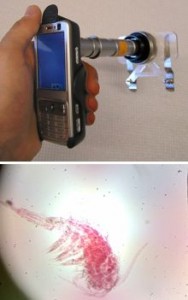Remote Microscopy using cell phones
Researchers at the University of California, Berkeley, have developed a modular, high-magnification microscope attachment for cell phones. The device will enable health workers in remote, rural areas to take high-resolution images of a patient’s blood cells using a cell-phone camera, and then transmit the photos to experts at medical centers.

“The challenge was to make a low-cost, durable device with a long battery life,” says David Breslauer, a graduate student in Fletcher’s lab. “As engineers, we initially wanted to make a whiz-bang gadget to take pictures of both skin and blood. But people in the field told us, ‘Once it gets too complicated, no one is going to want to use it. Make something simple that just does the task.'”
The total cost of the first prototype, built from off-the-shelf components, was $75. The current version provides its own sample illumination from cheap, low-power LEDs. The device comes in two versions: with a magnification of about 5 times, for taking images of moles and rashes, and with a magnification of about 60 times, for capturing the details of blood cells and parasites.
